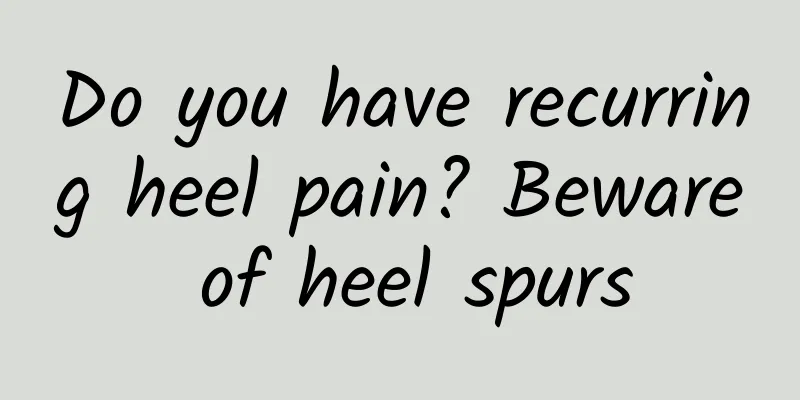Do you have recurring heel pain? Beware of heel spurs

|
Recurring pain in the heel, like a needle prick The pain gets worse with every step I take When I take off my shoes, I don't see any redness or swelling. I went to the hospital and took an X-ray. It was discovered to be a "heel bone spur"! Bone spur is the common name for bone hyperplasia. Calcaneus spur (also known as heel spur) is the bone hyperplasia of the heel bone of the foot. Calcaneus spur is a normal physiological degeneration phenomenon and a protective physiological reaction of the human body. Generally, this has no effect on a person's daily life. However, repeated injury can cause these deposits to build up on top of each other, resulting in a bone spur-shaped deformity called a calcaneal (or heel) spur. How do heel spurs form? Formation of calcaneal spurs Chronic strain leads to degeneration of surrounding soft tissue It is related to factors such as abnormal biomechanical mechanism of the foot There are several points as follows ↓↓↓ (1) Bone hyperplasia: With age, bones age and degenerate, causing bone hyperplasia, and in severe cases, bone spurs. (2) Arthritis: Long-term arthritis stimulates bone tissue to form bone spurs; (3) Trauma: Heel trauma causes fractures or bone damage, and discomfort symptoms are accompanied by bone spur formation; (4) Immune diseases. Clinical manifestations of calcaneal spur Symptoms of heel spurs The size of the bone spur and the duration of the disease Is there any relationship with inflammation? (1) When you push down on your heel, you feel a pricking sensation inside, and numbness when you touch it with your hand; (2) The outer surface of the heel is red and swollen, and it becomes hot when touched; (3) There is a tender spot in the center of the heel, which is very painful when pressed with fingers; (4) In severe cases, the patient cannot walk on the ground; (5) The pain will be aggravated by fatigue caused by long-distance walking. For example, if you accidentally step on bricks or tiles while walking or put too much force on the ground when going down stairs, it will cause severe pain. (6) Heel tenderness and pain in the sole of the foot, which is worse in the morning and less severe in the afternoon. The first step when getting up from bed is extremely painful, sometimes mild and sometimes severe. I dare not use my heel when walking, and there is a feeling of stone or needles. The symptoms are relieved after moving around. How to differentiate between heel spurs and heel pain? Heel pain, also known as heel pain, is pain on one or both sides of the heel, without redness or swelling, and inconvenience in walking. It is a disease caused by lesions in the bones, joints, bursae, fascia, etc. of the heel. Common plantar fasciitis often occurs in people who stand or walk for a long time, and is caused by long-term, chronic minor injuries. Heel pain is the main symptom of heel spurs, which usually eases during rest. Bone spurs do not necessarily cause heel pain, and plantar fasciitis does not necessarily cause bone spurs. How to treat heel spur? There is currently no specific treatment method in clinical practice. Conservative treatment is generally used to control the progression of the disease through oral medication, orthopedic insoles, and physical therapy . The formation of heel spurs is mainly related to chronic traction stress of the plantar fascia and Achilles tendon, abnormal load distribution, and bone hyperplasia during tissue repair. Orthopedic insoles can relieve the symptoms of heel spurs by adjusting the pressure distribution of the foot, supporting the arch of the foot, and reducing the load and traction on the heel bone. With the improvement of living standards, people are paying more and more attention to foot and ankle diseases. In order to provide the most accurate diagnosis and the best treatment plan, our team's gait analysis laboratory is equipped with the most advanced lower limb biomechanical analysis equipment. ①Mirror pressure test equipment: Mirror pressure test uses the principle of mirror reflection to intuitively observe the plantar pressure, arch type and biomechanical line of the lower limbs. ② Plantar scanning test equipment: Through 3D technology and white light mode projection, a 3D CAD model of the foot can be obtained through reverse engineering processing, which can accurately evaluate the abnormal conditions of the patient's lower limbs and obtain various foot data, such as foot shape, arch index, degree of inversion and valgus, etc. ③ Portable gait analysis equipment: Patients wear insoles equipped with sensors to perform a one-minute walking test, which can not only obtain the spatiotemporal and phase parameters of their walking process , but also obtain dynamic parameters , providing an objective and quantitative scientific basis, reducing the demand for space and manpower, and making gait assessment more efficient. Through these advanced equipment, our team is able to provide each patient with the most accurate diagnosis and the most appropriate treatment plan, helping them recover their health and improve their quality of life as soon as possible. |
<<: This is how people with scoliosis should sleep!
Recommend
Women who sleep naked are healthier
In Japan, sleeping naked has always been praised ...
Why is the discharge black when my period comes?
The color of menstrual blood has always been a pr...
What are the consequences of ovarian and hysterectomy?
If you suffer from some uterine diseases or ovari...
Amniotic fluid infusion has effect after a few days
Every pregnant woman needs to be aware of the hug...
What to do if the American shorthair is not smooth? How to make the cat's hair shiny
Cats are very cute animals. There are many variet...
Can pregnant women eat fragrant pears?
Fragrant pear is a very delicious food, but pregn...
Why does the anus swell during menstruation?
Many girls experience abnormal phenomena during m...
In which week does the gestational sac implant?
When a woman is pregnant, her family will be too ...
Can pregnant women drink corn porridge?
Pregnant women cannot just eat rice or some whole...
There is a peculiar smell in the lower body and the vagina is yellow
Discharge is a normal physiological need of the f...
Should I check with B-ultrasound or vaginal ultrasound after IUD insertion?
Women should do a good job of follow-up after the...
What causes small red spots in the vagina?
It is hot in summer and with high temperatures, v...
Reasons for white tongue in pregnant women
Anyway, pregnant friends will have reduced immuni...
What should I do if I sweat during the full month after giving birth?
Some pregnant women will sweat one month after gi...









